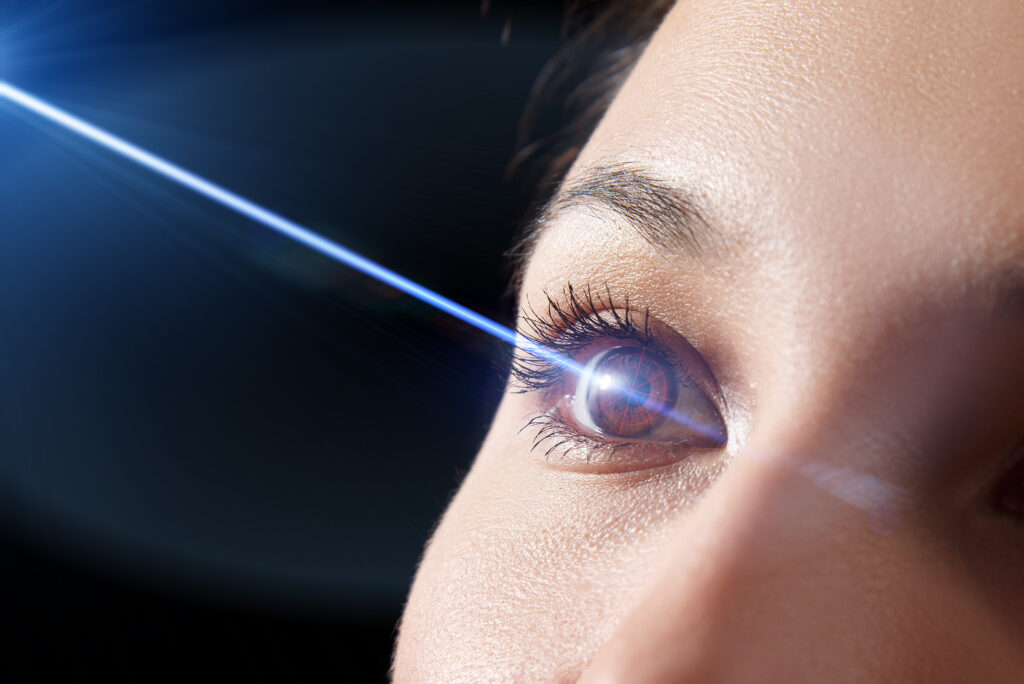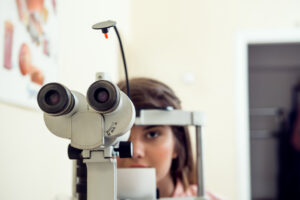Overview

Laser eye surgery, also known as laser-assisted in situ keratomileusis (LASIK), is used to treat astigmatism, hyperopia, and myopia. To address refractive defects and visual issues, the cornea must be reshaped.
At a time when people with refractive error were severely impaired or practically blind, the invention of eyeglasses was a significant achievement. Long-term popularity However, spectacles have several drawbacks, including unsightly blemishes, a narrower range of vision, aberrations, obstructions during sporting events, and physical pain. This does not, however, imply that spectacles should be disapproved of. For many people, the only option left for vision restoration is to continue wearing spectacles, which are a good visual aid.
The question “Why should we depend on prostheses when it is possible to restore natural vision with all its inherent advantages (not just cosmetic)” is one that ophthalmologists and patients alike find themselves wondering about time and time again. LASIK surgery holds the key to all our questions and fears.
GET A CALL BACK FROM OUR HEALTH ADVISOR
Email – info@narangeyeinstitute.net
We will never share your info
What Is LASIK (Laser Assisted In- Situ Keratomileusis)?
As of right now, LASIK is the most effective way to repair refractive problems. It is secure, reliable, and accurate. A very thin (110–160 micron) layer of the cornea—the visible portion of the eye—is elevated during LASIK surgery. The cornea is then moulded into a preset curvature using a computer-controlled Wavelight Allegretto Excimer Laser (Argon Fluoride 193nm). Astigmatism, hypermetropia, and myopia are corrected as a result. The process is quick, easy to understand, and extremely accurate because it is computer-controlled.
Types of LASIK Eye Surgery
Custom or Wave-Front Optimised LASIK
Wave-front guided or personalized LASIK assesses and seeks to correct higher-order aberrations in the eye’s optical system. Additionally, the maps created for LASIK therapy preserve the cornea’s natural (prolate) profile, preventing aberrations from being introduced. Increased contrast and night vision are the results of all of this.
Intra LASIK (Femto Second LASIK)
Also known as INTRALASE, I LASIK, bladeless LASIK, or all LASER LASIK. This type of LASIK involves raising the corneal flap with a femtosecond LASER microkeratome as opposed to a mechanical one that uses a blade. Therefore, the method used to form the LASIK flap is the only variation. It is false to believe that there is no cutting; so, the hazards associated with flaps are the same for both laser and blade. With femtosecond lasers, thinner flaps may be safer and the width of the flaps may be more predictable in the intralase group. Nonetheless, the excimer LASER correction of the stromal bed’s refractive defect is identical to that of LASIK.
EPI-LASIK Or LASIK/PRK
Patients with thin corneas may benefit from LASER, which removes epithelium using alcohol, or Epi-LASIK, which lifts just a small epithelial flap. To obtain a higher refractive correction, more tissue is left behind in the corneal bed. PRK has the same effect when used in conjunction with Mitomycin-C. While more refractive error can be corrected with these techniques than with LASIK, recovery from the procedure is slower and more unpleasant, and there is a larger risk of corneal haze, especially with higher correction levels.
Who is Perfect Candidate for LASIK Operation?
Deciding who is a good candidate for eye surgery is very essential. The crucial elements are:
- Refractive error: Hypermetropia up to 6 diopters or Myopia between -1 and -12 diopters
- Minimum age of 18 to 21 years old
- For the previous year or two, refraction ought to have been consistent.
- A person cannot have LASIK if they have keratoconus, thin corneas, corneal inflammatory illnesses, herpetic keratitis, or autoimmune diseases.
Preoperative Before the Preparation
- Seeing in a cycloplegic state
- Topography of the cornea
- Aberrometry
- Ultrasonic pachymetry (for determining corneal thickness)
- A thorough inspection of the retina
- Evaluation of intraocular pressure
- Procedure for informed consent
LASIK Surgery Procedure
There is no need for an injection because LASIK is done under eye drop anesthesia. With a high-speed (250 Hz) eye tracking system, the Wavelight Allegretto LASIK machine is equipped. This apparatus continuously tracks the location of the eye and precisely repositions the laser. Procedures for laser eye surgery include:
- The patient’s face is covered with a drape to reveal only one eye after the anesthetic. After the eyelids are retracted with an eyelid speculum, the patient is made to stare at a green light that is blinking.
- The cornea is surrounded by a vacuum ring, which both stabilizes the eyeball and provides a surface for the microkeratome. There is pressure on the eyes and blurry vision when the hover is turned on.
- The corneal flap is folded back after the automated Moria Microkeratome slices through the cornea’s outer layers. The patient hears the sound of a motor in front of their eye during this step.
- The stromal bed is ablated using the Wavelight Allegretto high-speed (200 Hz) excimer laser to resurface it with the required curvature. The Excimer laser’s capacity to precisely destroy tissue with each pulse—up to 0.25 microns—makes it an excellent choice for corneal ablation. Frequently, the appropriate degree of correction can be obtained by removing only 50 microns of tissue.
- After that, the corneal flap is replaced and given some time to dry. Sutures are not necessary because the flap self-seals.
- Eye drops and antibiotics are prescribed. The patient is told to return the next day.
Eye Operation Precautions
- For a month, refrain from swimming and splattering water in your eyes.
- Do not massage your eyes for a month.
- To escape the harsh sun, dust, wind, and pollutants in the air, use sunglasses.
- Don’t spend too much time watching TV or using computers for a week.
- Take medications as prescribed regularly.
- Should you have any concerns, speak with your eye surgeon.
Problems with Laser Eye Treatment
While there are always risks associated with surgery, LASIK is a reasonably safe method of correcting refractive problems. Uncommon side effects include glare, slight over- or under-correction, diminished contrast sensitivity, epithelial growth, etc.
Only a small percentage of flap-related issues require the surgeon to postpone the LASIK procedure for better management; these difficulties are also an uncommon possibility and can be handled on the table.
- Inadequate or excessive correction
- Flap’s button-holing
- Diminished sensitivity to contrast
- Corneal hole
- Scowl
- Island in the center
- Decentration of the Ablation
- Virus Infection
- The astigmatic
- Infiltration of the cornea
- Damage to the flaps
- Ulcers on the cornea
Pain Management in LASIK Operation
No, there is no discomfort felt by the patient. The patient just feels a tiny pressure during the safe and painless operation. The patient finds the process to be rather comfortable.
What are the Results of Eye Surgery?
The majority of patients get very excellent results, with reports indicating that over 90% of properly chosen cases achieve unaided visual acuity of 6/12 or better (6/12, 6/9, 6/6, and 6/5). The patients’ subjective levels of satisfaction varied from one another. While some people may feel extremely content with a vision of 6/12, others may not be at all content even with a vision of 6/5.
How Much Time Laser LASIK Surgery Take?
A typical LASIK patient’s schedule looks like this:
Day 1: Comprehensive ocular examination
Day 2: LASIK surgery (stay at the center for 2-4 hours)
Day 3: Postoperative checkup review visit
Day 7: Review for the test
Patients may travel from day three to day seven.
Why Choose Narang Eye Institute For LASIK Surgery?

- Modern infrastructure featuring cutting-edge laser technology
- A specifically created operating room to ensure optimal sterility
- Thorough pre-LASIK screening to evaluate the candidate’s suitability for the procedure before it happens.
- Utilizing precise ultrasonic devices to measure corneal thickness and an advanced corneal topography system to ensure precision.
- Single-use disposable supplies for maximum patient safety, sterility, accuracy, and precision.
- Extremely talented and experienced surgeons with the assistance of trained personnel
Our Services
- Surgery for Glaucoma & Retina Laser
- Lasik: Bladeless Laser
- Diabetic Eye Care
- Paediatric Eye care
- Oculoplasty
- Squint Correction
- Corneal Transplant Surgery
- Eyelid Cosmetic Surgery
- Cataract & Lens Implant Surgery: MICS& Laser
Frequently Asked Questions About Lasik Eye Surgery

When Can I Get Back to My Regular Activities?
Because the surgery is straightforward, the recuperation happens fairly quickly. With just a few precautions, one can return to their regular activities as soon as 24 to 48 hours after the procedure.
Will the Surgery Restore My Power?
No, power never resurfaces. Only in extreme circumstances, such as when the patient’s initial refractive power was extremely high, may there be a limited residual power that can be addressed by what are known as enhancements. These can be evaluated once more only a few months after the procedure, depending on the patient’s needs.
Is It Possible for Me to Go Blind?
No, no cases of blindness have been documented as of yet.
Are There Any Potential Difficulties?
While there is little likelihood of issues developing, our surgeons are highly skilled in handling them should they arise.
Is Laser Eye Treatment Permanent?
Indeed, the results of LASIK surgery are meant to endure a lifetime. Reading glasses are only necessary beyond the age of forty.










